Barb
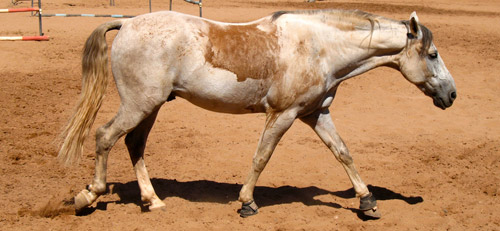
Intro
One of the ancestoral breeds, the Barb has bloodlines as old or older than theArabian horse. Like the Arabian, it is a desert horse, however that is where their similarities end.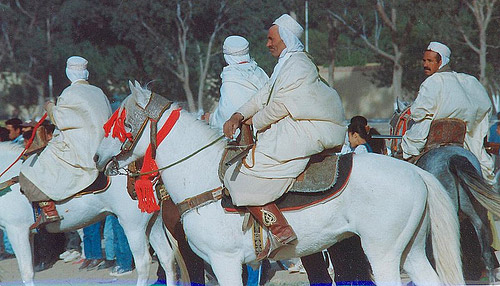

Origins
It is believed that the Arabian and Barb bloodlines met at some point during the Muslim conquests in he 7th and 8th centuries. Many of the Barb’s confirmation charactoristics proved to be dominate and few of the Arabian refinements are seen in pure Barb bloodlines.
Playing a large part in the evolution of most Spanish breeds, especially theAndalusian, the Barb blood also played a part in the modern day Thoroughbred.
Still found in plentiful numbers in Morocco, Algeria and Tunisia the stallions are traditionally used as the mounts for the Spahi cavalry.
Still found in plentiful numbers in Morocco, Algeria and Tunisia the stallions are traditionally used as the mounts for the Spahi cavalry.
Features
Average height 14.2-15.2 hands
Built to cover long distances on meager rations
Drought resistant
Great stamina
Agile movement
Built to cover long distances on meager rations
Drought resistant
Great stamina
Agile movement
Physique
Straight profile
Arched neck
Flat, upright shoulders
Rounded hindquarters, low set tail
Legs are slender and hard
Narrow, durable feet
Arched neck
Flat, upright shoulders
Rounded hindquarters, low set tail
Legs are slender and hard
Narrow, durable feet
Traditional Colors
Temperament
High strung desert horse, bred for speed and spirit
Tough and resistant
Unstable personality
Tough and resistant
Unstable personality
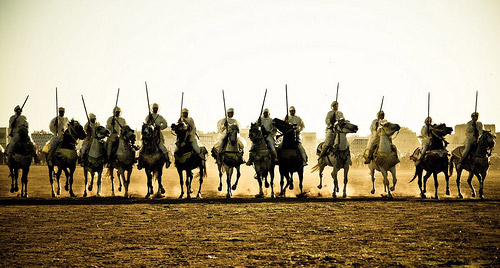
Image from {tribal} photography
Use
Military horses
General riding
Competition horse
Agriculture work
General riding
Competition horse
Agriculture work
Helpful links
*All links open in a new window
Barb Horse French Association
Original Horses
Saudi Aramco World.com
Barb Horse French Association
Original Horses
Saudi Aramco World.com
Where to Buy
Video
Bardigiano
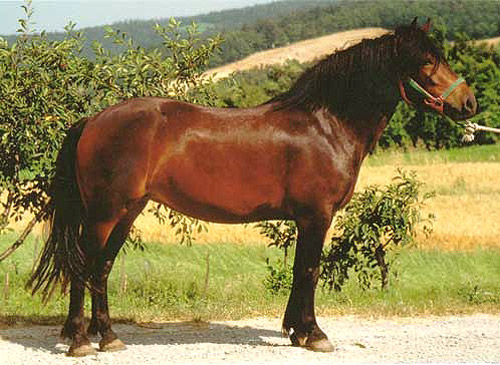
Intro
During WWII Italian Bardigiano mares were used to produce mules to feed the war and in the process nearly decimated the pureblood of the breed.

Origins
The origin of this breed comes from the horses of Belgian Gauls who invaded Italy during Roman times. The same ancestor thought to produce the Haflinger. The Bardigiano also shows physical similarities to the Exmoor and Dales ponies and theAsturcon.
After WWII stallions of several different breeds were introduced to the area and the bloodlines became even more diluted, as did the specific traits of the original breed.
However small herds of pureblood animals were found, preserved by mountain agriculturists in the area. In 1977 the breed was officially recognized in an attempt to preserve and document their bloodlines.
Features
Average height 13.2 – 14.1 hands
Small and sturdy
Small and sturdy
Physique
Head is light, has a slightly concave profile, and a jutting upper lip
Neck is arched with a wide base and thick crest
Medium length back
Legs are slim and strong
Hooves are large and very hard
Neck is arched with a wide base and thick crest
Medium length back
Legs are slim and strong
Hooves are large and very hard
Traditional Colors
Temperament
Docile nature and easy to work with
Great children’s horse
Great children’s horse
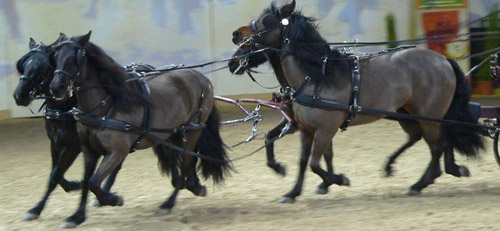
Use
Mountain trekking
Horse therapy
Show horses
Meat
Pleasure horse
Horse therapy
Show horses
Meat
Pleasure horse
Video
Barra Pony
Intro
The Barra or Bara pony is an extinct breed as of the mid 1900′s, but was once a variety of the Hebridean Pony.
Origins
This pony comes from Hebrides, Scotland & they were used for transportation, cart horses and pack animals.
Features
Average height 14.3 hands
Physique
Head is small for the body with small ears
Neck is medium length and well connected
Chest is ample & deep
Substantial withers
Back is long & croup is sloped
Legs are gangly & large-jointed
Rump too small for the body size
Mane & tail bushy & tail is low set
Neck is medium length and well connected
Chest is ample & deep
Substantial withers
Back is long & croup is sloped
Legs are gangly & large-jointed
Rump too small for the body size
Mane & tail bushy & tail is low set
Traditional Colors
Predominately bay
Barthais Pony
Intro
The Barthais was once classified as a heavy horse and their roots are thought to go back to France pre 7th century AD (Arabian blood was added for the first time in 732 AD). Through the years their bloodlines have become lighter and smaller to the present day animal which is now classified as a pony.
Origins
The Barthais Pony is very much like the Landais Pony, although more robust and used for agriculture and other heavy work. This breed comes from France near the Stribrnem shore & is the result of local stock crossed with Berber. Once considered their own separate breed, there are no pure animals left & they have been incorporated into the Landais pony.
Features
Average height 11.8 – 13.2 hands
Sturdy & tough
Has a natural “kick” action in its stride
Sturdy & tough
Has a natural “kick” action in its stride
Physique
Head is small for size, but handsome
Ears are alert & eyes are intelligent
Body is muscular & sturdy
Legs are strong & slender
Pasterns are long with natural pump action
Mane & tail are full and tail is carried high
Ears are alert & eyes are intelligent
Body is muscular & sturdy
Legs are strong & slender
Pasterns are long with natural pump action
Mane & tail are full and tail is carried high
Traditional Colors
Temperament
Willing & kind
Use
Riding pony
Work pony
Work pony
Bashkir Horse

Intro
Native to the unforgiving climate in the steppe regions south of the Ural Mountains, the Bashkir Horse is by nature a tough animal. Enduring long cold winters and short hot summers.
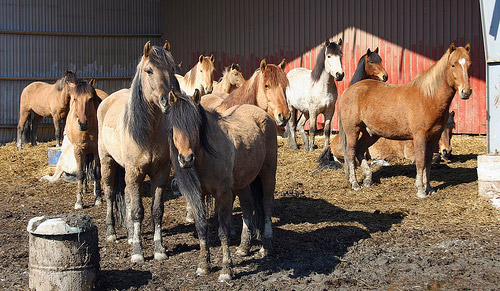
Origins
This is an ancient breed that has been bred for centuries by the Bashkiri people. Domestic breeding of horses was an established practice long before Mongols appeared in the area. While the blood of the Mongol horses may have been introduced to the Bashkir, it is not the foundation of the breed.
The Bashkir horse bloodline is descendant of the steppe horses from western Asia. The effect of their specific climate created characteristics that differ from other breeds that share the same ancestors, they are much heavier in build.
The mares are used heavily for milk production from April to August every year. During this time the foals are kept from the mares during the day so they can be milked, then allowed to feed at night. This has had an adverse effect on the development of the young animals and the breed in general suffers in quality because of it.
Cross breeding with a number of different breeds has been attempted, however crosses with lighter breeds rarely retain the hardiness of the Bashkir blood.
There are two recognized types
Mountain type – smaller draft-type
Steppe type – tallier and of lighter build saddle- harness-type
Mountain type – smaller draft-type
Steppe type – tallier and of lighter build saddle- harness-type
Both types of the breed have a very high work tolerance and are known for their hardiness under saddle.
They have an interesting link to the American Bashkir horse which is obviously of the same origin. The American Curlies are thought to have been first noticed in mustangs in the early 19th century, making their feral existence on the North American continent a mystery.
Features
Average height 13.1 – 14 hands
Versitile and useful
Healthy and well adapted for its habitat
Versitile and useful
Healthy and well adapted for its habitat
Physique
Massive head
Short, fleshy neck
Broad back
Chest is deep and broad
Legs are short and bony
Coat is long and curly
Mane and tail is thick and grows long with winter coat
Short, fleshy neck
Broad back
Chest is deep and broad
Legs are short and bony
Coat is long and curly
Mane and tail is thick and grows long with winter coat
Traditional Colors
Temperament
Strong and sensible with a good disposition
Use
Riding horse
Draft horse
Milk
Meat
Draft horse
Milk
Meat
Helpful Links
*All links open in a new window
Swedish Bashkir Horse Association
Swedish Bashkir Horse Association
Basotho Pony
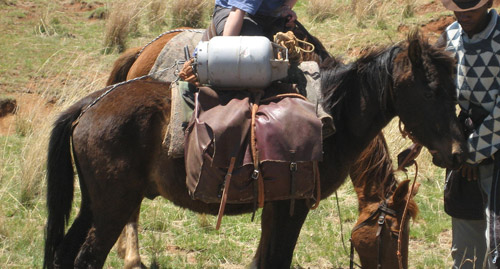
Intro
The Basotho Pony, also called Basuto is native to an enclave of South Africa called Lesotho. An inhospitable climate, high altitude and steep terrain have created an incredibly tough little animal.
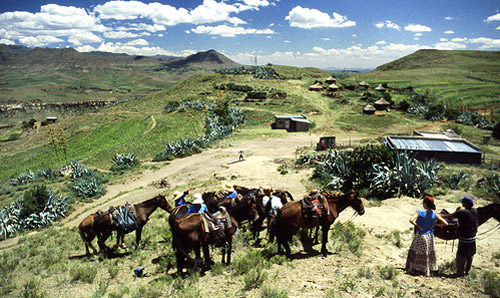
Origins
This breed comes from the Cape Horse of South Africa which are of Java pony background. They do display influence of Persian, Arabian and Thoroughbred blood, although it is unclear if it was introduced to the animals prior to being imported to the area or later to enhance bloodlines.
The Basotho was exported to both the UK and Europe for use as war horses, and they were prized for their endurance and low-maintenance care.
In 1977 the breed was facing extinction and a rigerous breeding program was established assisted by the Irish Government in the hopes of preserving and documenting the bloodlines of the breed.
Features
Average height 14.2 hands
Compact, sturdy and surefooted
Compact, sturdy and surefooted
Physique
Head is medium sized with a heavy jaw and straight profile
Neck is long and slender
Back is long and straight
Chest is deep and shoulder is straight
Legs are slim and strong with clean joints
Hooves are very hard
Neck is long and slender
Back is long and straight
Chest is deep and shoulder is straight
Legs are slim and strong with clean joints
Hooves are very hard
Traditional Colors
Temperament
Spirited and intelligent
Amiable and friendly
Amiable and friendly
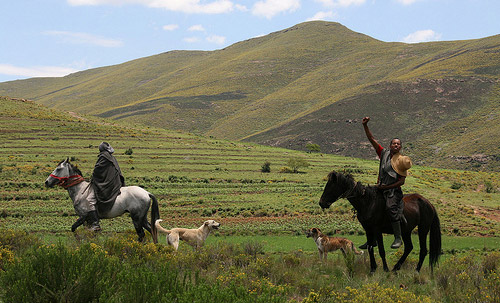
Use
Pack pony
Riding pony
Transportation
Riding pony
Transportation
Helpful Links
*All links open in a new window
Malealea Lodge
The State of the Basotho Pony in Lesotho
Malealea Lodge
The State of the Basotho Pony in Lesotho
Video
Basque Pony
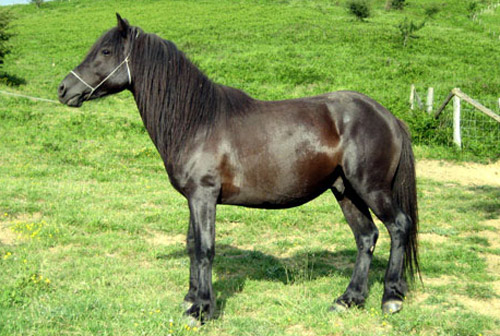
Image from Pottoka
Intro
Also called Pottok, the Basque Ponies are left to live wild in the Pyrenees. The last Wednesday of January they are rounded up, their numbers cut for market and the remaining animals are branded and released.
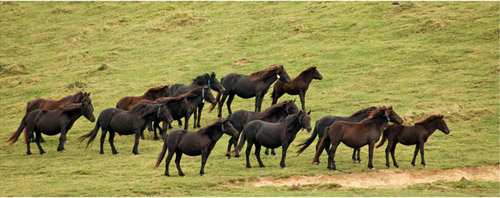
Image from Pottoka
Origins
This is a small ancient pony breed that has roamed wild in the Pyrenees for centuries, and may date back 10,000 years. They are thought to be descendant of the Magdalenian horses of 14,000 – 7,000 B.C.
Rapid growth to maturity helps the animals survive the harsh climate they live in and they are fully grown by the time they are 2 years of age.
Early in the 20th century Basque ponies were used as pit ponies in French and British mines. Later, their mild temperament and easy nature made them popular as children’s mounts. Arabian and Welsh pony blood has been introduced to the breed for further refinement as riding ponies.
Although there is some cross-breeding, the French plan to preserve the breed and keep a number of stock that is to remain of pure blood.
Features
Average height 11.2 – 13 hands
Hardy and easy to care for
Hardy and easy to care for
Physique
Large head with short ears and lively eyes
Neck is short
Back is long
Legs are strong
Hooves are small and hard
Neck is short
Back is long
Legs are strong
Hooves are small and hard
Traditional Colors
Temperament
Docile and kind
Willing and even-tempered
Willing and even-tempered
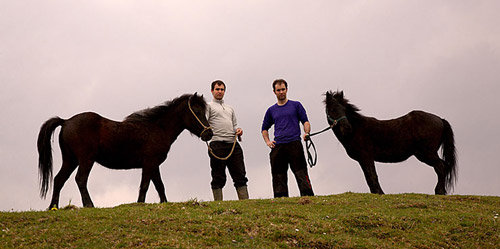
Image from Pottoka
Use
Performing ponies
Riding pony
Competition pony
Riding pony
Competition pony
Helpful Links
*All links open in a new window

No comments:
Post a Comment